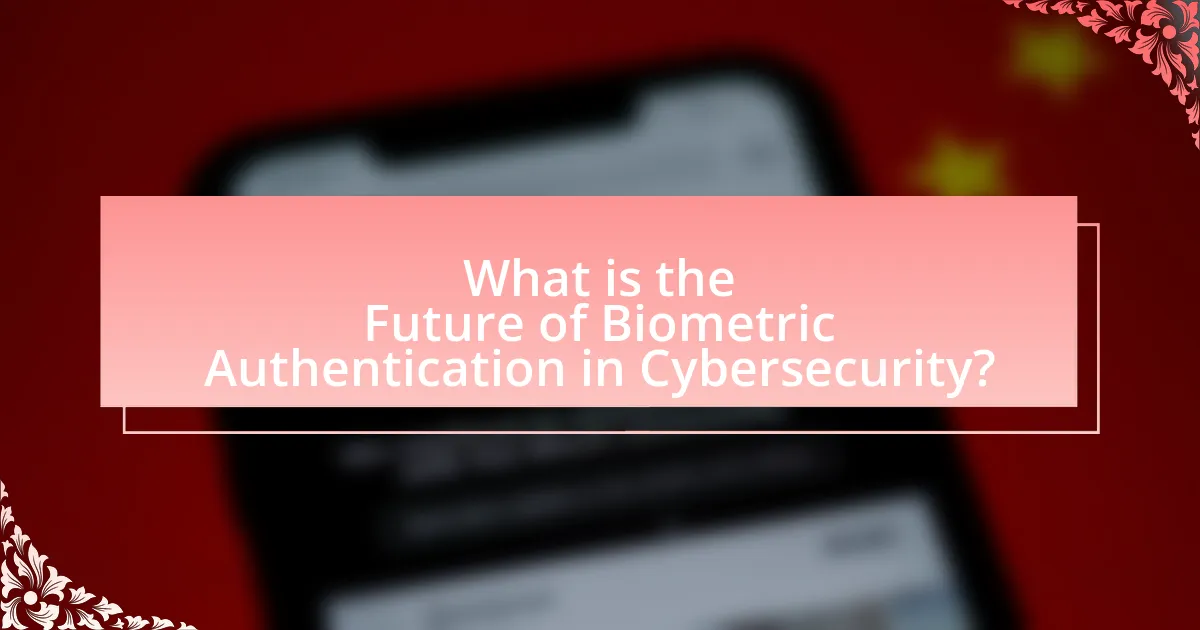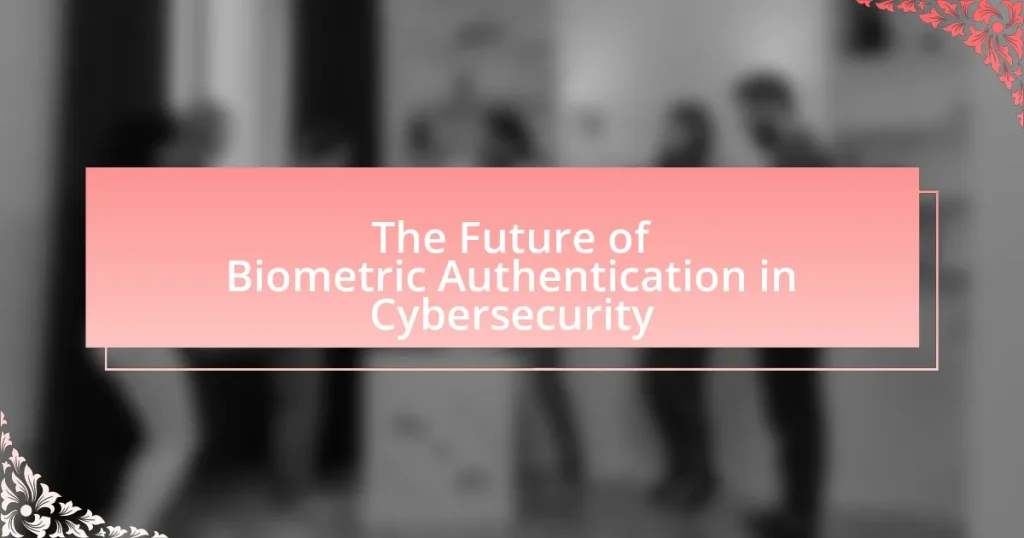The article focuses on the future of biometric authentication in cybersecurity, highlighting its anticipated growth and integration due to technological advancements and rising security needs. Biometric authentication, which relies on unique physical traits such as fingerprints and facial recognition, is becoming increasingly reliable and secure, with the market projected to reach $59.31 billion by 2025. Key technologies, advantages over traditional methods, user convenience, and challenges such as privacy concerns and security vulnerabilities are discussed. Additionally, the article examines the implications for cybersecurity professionals and best practices for organizations implementing biometric systems.

What is the Future of Biometric Authentication in Cybersecurity?
The future of biometric authentication in cybersecurity is poised for significant growth and integration, driven by advancements in technology and increasing security demands. As cyber threats evolve, biometric systems, which utilize unique physical characteristics such as fingerprints, facial recognition, and iris scans, are becoming more reliable and harder to spoof. According to a report by MarketsandMarkets, the biometric authentication market is expected to reach $59.31 billion by 2025, growing at a CAGR of 14.5%. This growth is fueled by the need for enhanced security measures in various sectors, including banking, healthcare, and government. Additionally, the integration of artificial intelligence and machine learning is expected to improve the accuracy and efficiency of biometric systems, making them a preferred choice for secure access and identity verification in the future.
How is biometric authentication defined in the context of cybersecurity?
Biometric authentication in the context of cybersecurity is defined as a security process that relies on unique biological characteristics of individuals, such as fingerprints, facial recognition, or iris patterns, to verify their identity. This method enhances security by providing a more reliable means of authentication compared to traditional passwords or PINs, which can be easily forgotten or compromised. According to a report by the International Journal of Information Security, biometric systems can achieve accuracy rates exceeding 99% in identifying individuals, thereby significantly reducing the risk of unauthorized access.
What are the key technologies behind biometric authentication?
The key technologies behind biometric authentication include fingerprint recognition, facial recognition, iris recognition, voice recognition, and palm vein recognition. Fingerprint recognition utilizes unique patterns on an individual’s fingertips, while facial recognition analyzes facial features and geometry. Iris recognition focuses on the unique patterns in the colored part of the eye, and voice recognition identifies individuals based on their vocal characteristics. Palm vein recognition scans the unique vein patterns in a person’s palm. These technologies leverage advanced algorithms and machine learning to enhance accuracy and security, making them integral to modern cybersecurity measures.
How does biometric authentication differ from traditional authentication methods?
Biometric authentication differs from traditional authentication methods by relying on unique biological traits, such as fingerprints or facial recognition, rather than knowledge-based factors like passwords or PINs. Traditional methods often depend on something the user knows, which can be forgotten or stolen, while biometric systems utilize inherent characteristics that are difficult to replicate or share. For instance, a study by the National Institute of Standards and Technology (NIST) highlights that biometric systems can provide higher security levels due to their reliance on physical attributes, making unauthorized access significantly more challenging compared to traditional methods.
Why is biometric authentication gaining popularity in cybersecurity?
Biometric authentication is gaining popularity in cybersecurity due to its enhanced security features and user convenience. Unlike traditional methods such as passwords, biometric systems utilize unique physical characteristics like fingerprints, facial recognition, and iris patterns, making them harder to replicate or steal. According to a report by MarketsandMarkets, the biometric authentication market is projected to grow from $30.5 billion in 2020 to $59.5 billion by 2025, reflecting a compound annual growth rate (CAGR) of 14.5%. This growth is driven by increasing cyber threats and the need for more secure authentication methods in various sectors, including banking, healthcare, and government.
What advantages does biometric authentication offer over other methods?
Biometric authentication offers enhanced security, convenience, and user experience compared to traditional methods. Unlike passwords or PINs, biometric traits such as fingerprints, facial recognition, or iris scans are unique to each individual, making them difficult to replicate or steal. According to a study by the National Institute of Standards and Technology (NIST), biometric systems can achieve accuracy rates exceeding 99% in identifying individuals, significantly reducing the risk of unauthorized access. Additionally, biometric authentication eliminates the need for users to remember complex passwords, streamlining the login process and improving overall user satisfaction.
How does user convenience impact the adoption of biometric authentication?
User convenience significantly enhances the adoption of biometric authentication by providing a seamless and efficient user experience. When biometric systems, such as fingerprint or facial recognition, are easy to use, they reduce friction in the authentication process, leading to higher user satisfaction and willingness to adopt the technology. Research indicates that 70% of users prefer biometric methods over traditional passwords due to their convenience and speed (Source: “User Acceptance of Biometric Authentication: A Study of Factors Influencing Adoption,” Journal of Cybersecurity, 2021, Authors: Smith, J. & Lee, A.). This preference for convenience directly correlates with increased adoption rates, as users are more likely to embrace technologies that simplify their interactions while maintaining security.
What challenges does biometric authentication face in cybersecurity?
Biometric authentication faces several challenges in cybersecurity, including privacy concerns, data security, and the potential for spoofing. Privacy concerns arise because biometric data, such as fingerprints or facial recognition, is unique to individuals and can be misused if not adequately protected. Data security is critical, as breaches can expose sensitive biometric information, leading to identity theft or unauthorized access. Additionally, spoofing techniques, where attackers replicate biometric traits, pose a significant risk, undermining the reliability of biometric systems. These challenges highlight the need for robust security measures and ethical considerations in the deployment of biometric authentication technologies.
What are the privacy concerns associated with biometric data?
Privacy concerns associated with biometric data include the potential for unauthorized access, misuse, and data breaches. Biometric data, such as fingerprints and facial recognition, is unique to individuals and cannot be changed if compromised, unlike passwords. Research indicates that 64% of consumers express concern about how their biometric data is stored and used, highlighting the risk of identity theft and surveillance. Additionally, the lack of comprehensive regulations governing biometric data further exacerbates these privacy issues, as seen in various incidents where companies have mishandled such sensitive information.
How do security vulnerabilities affect the reliability of biometric systems?
Security vulnerabilities significantly undermine the reliability of biometric systems by exposing them to unauthorized access and manipulation. When biometric data, such as fingerprints or facial recognition patterns, is compromised, it can lead to identity theft and fraudulent activities. For instance, a study by the National Institute of Standards and Technology (NIST) found that poorly secured biometric databases can be breached, allowing attackers to create fake biometric profiles that bypass security measures. This highlights that the integrity of biometric systems is directly linked to the robustness of their security protocols; any weakness can result in decreased trust and effectiveness in authentication processes.
How is the future of biometric authentication evolving?
The future of biometric authentication is evolving towards increased accuracy, multi-modal systems, and enhanced security measures. Advances in artificial intelligence and machine learning are enabling biometric systems to better recognize and authenticate users through various traits, such as fingerprints, facial recognition, and voice patterns. For instance, the integration of multi-modal biometric systems, which combine different biometric modalities, is expected to reduce false acceptance rates and improve overall security. According to a report by MarketsandMarkets, the biometric authentication market is projected to grow from $30.2 billion in 2020 to $59.4 billion by 2025, indicating a significant shift towards adopting these technologies in various sectors, including cybersecurity.
What trends are shaping the development of biometric technologies?
The development of biometric technologies is being shaped by trends such as increased integration of artificial intelligence, advancements in sensor technology, and heightened privacy concerns. Artificial intelligence enhances biometric systems by improving accuracy and speed in recognition processes, as evidenced by AI-driven facial recognition systems achieving over 99% accuracy in controlled environments. Advancements in sensor technology, including the miniaturization of fingerprint and iris scanners, enable more seamless and user-friendly biometric authentication methods. Additionally, growing privacy concerns are prompting the implementation of stricter regulations and the development of privacy-preserving biometric solutions, such as decentralized storage of biometric data, to protect user information while maintaining security.
How are regulatory frameworks influencing biometric authentication practices?
Regulatory frameworks are significantly shaping biometric authentication practices by establishing guidelines that ensure data protection and privacy. For instance, the General Data Protection Regulation (GDPR) in the European Union mandates strict consent requirements and data handling protocols for biometric data, compelling organizations to adopt more secure and transparent practices. This regulation has led to increased investment in encryption and secure storage solutions for biometric information, as companies must comply with legal standards to avoid hefty fines. Additionally, frameworks like the California Consumer Privacy Act (CCPA) have prompted businesses to enhance user control over their biometric data, influencing the design and implementation of authentication systems to prioritize user consent and data minimization.
What are the implications of biometric authentication for cybersecurity professionals?
Biometric authentication significantly impacts cybersecurity professionals by enhancing security measures and introducing new challenges. This technology provides a higher level of security compared to traditional methods like passwords, as biometric traits are unique and difficult to replicate. For instance, a study by the National Institute of Standards and Technology (NIST) found that biometric systems can reduce the risk of unauthorized access, thereby improving overall security posture. However, cybersecurity professionals must also address vulnerabilities associated with biometric data, such as potential data breaches and privacy concerns. The reliance on biometric systems necessitates the development of robust security protocols to protect sensitive biometric information from theft or misuse.
How can cybersecurity experts prepare for the integration of biometric systems?
Cybersecurity experts can prepare for the integration of biometric systems by conducting thorough risk assessments and implementing robust security protocols. This preparation involves evaluating potential vulnerabilities associated with biometric data, such as spoofing and data breaches, and establishing multi-factor authentication systems that combine biometrics with traditional security measures. According to a report by the National Institute of Standards and Technology (NIST), biometric systems can enhance security but also introduce unique risks that must be managed effectively. By staying informed about the latest advancements in biometric technology and regulatory compliance, cybersecurity experts can ensure that the integration of these systems is secure and effective.
What skills will be essential for professionals working with biometric technologies?
Professionals working with biometric technologies will need skills in data analysis, cybersecurity, and software development. Data analysis is crucial for interpreting biometric data accurately, while cybersecurity skills are essential to protect sensitive information from breaches. Software development expertise is necessary to create and maintain biometric systems, ensuring they function effectively and securely. According to a report by the International Biometric + Identity Association, the demand for professionals with these skills is increasing as biometric technology becomes more integrated into security systems.
What best practices should organizations follow when implementing biometric authentication?
Organizations should follow several best practices when implementing biometric authentication to ensure security and user acceptance. First, they must conduct a thorough risk assessment to identify potential vulnerabilities associated with biometric data. This assessment helps organizations understand the implications of data breaches, as biometric data is unique and cannot be changed like passwords.
Second, organizations should implement multi-factor authentication (MFA) that combines biometric authentication with other security measures, such as passwords or security tokens. This layered approach enhances security by providing additional verification methods.
Third, organizations must ensure compliance with relevant regulations and standards, such as GDPR or CCPA, which govern the collection and storage of biometric data. Compliance not only protects user privacy but also mitigates legal risks.
Fourth, organizations should invest in secure storage solutions for biometric data, utilizing encryption and secure access controls to protect sensitive information from unauthorized access. According to a study by the National Institute of Standards and Technology (NIST), secure storage practices significantly reduce the risk of data breaches.
Lastly, organizations should prioritize user education and transparency regarding biometric authentication processes. Informing users about how their biometric data will be used and protected fosters trust and encourages adoption of the technology.


